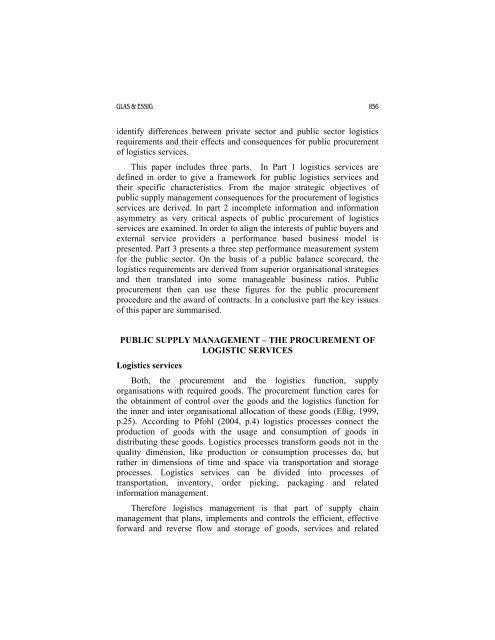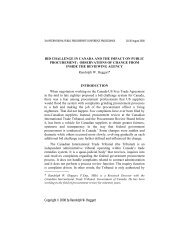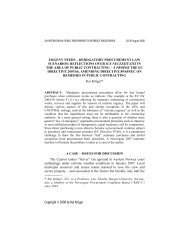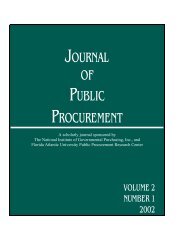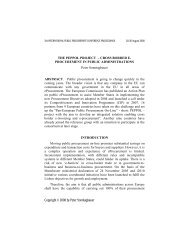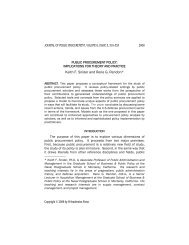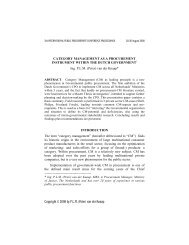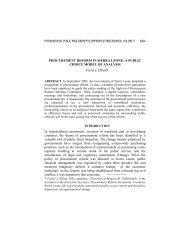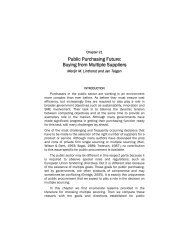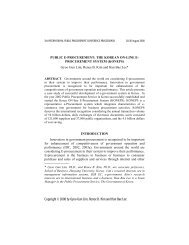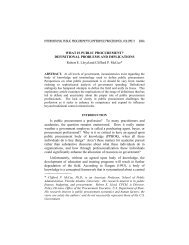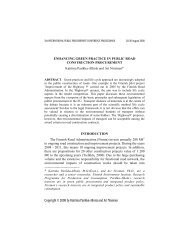Procurement of Integrated Logistics Services in the Public Sector
Procurement of Integrated Logistics Services in the Public Sector
Procurement of Integrated Logistics Services in the Public Sector
You also want an ePaper? Increase the reach of your titles
YUMPU automatically turns print PDFs into web optimized ePapers that Google loves.
GLAS & ESSIG 856identify differences between private sector and public sector logisticsrequirements and <strong>the</strong>ir effects and consequences for public procurement<strong>of</strong> logistics services.This paper <strong>in</strong>cludes three parts. In Part 1 logistics services aredef<strong>in</strong>ed <strong>in</strong> order to give a framework for public logistics services and<strong>the</strong>ir specific characteristics. From <strong>the</strong> major strategic objectives <strong>of</strong>public supply management consequences for <strong>the</strong> procurement <strong>of</strong> logisticsservices are derived. In part 2 <strong>in</strong>complete <strong>in</strong>formation and <strong>in</strong>formationasymmetry as very critical aspects <strong>of</strong> public procurement <strong>of</strong> logisticsservices are exam<strong>in</strong>ed. In order to align <strong>the</strong> <strong>in</strong>terests <strong>of</strong> public buyers andexternal service providers a performance based bus<strong>in</strong>ess model ispresented. Part 3 presents a three step performance measurement systemfor <strong>the</strong> public sector. On <strong>the</strong> basis <strong>of</strong> a public balance scorecard, <strong>the</strong>logistics requirements are derived from superior organisational strategiesand <strong>the</strong>n translated <strong>in</strong>to some manageable bus<strong>in</strong>ess ratios. <strong>Public</strong>procurement <strong>the</strong>n can use <strong>the</strong>se figures for <strong>the</strong> public procurementprocedure and <strong>the</strong> award <strong>of</strong> contracts. In a conclusive part <strong>the</strong> key issues<strong>of</strong> this paper are summarised.PUBLIC SUPPLY MANAGEMENT – THE PROCUREMENT OFLOGISTIC SERVICES<strong>Logistics</strong> servicesBoth, <strong>the</strong> procurement and <strong>the</strong> logistics function, supplyorganisations with required goods. The procurement function cares for<strong>the</strong> obta<strong>in</strong>ment <strong>of</strong> control over <strong>the</strong> goods and <strong>the</strong> logistics function for<strong>the</strong> <strong>in</strong>ner and <strong>in</strong>ter organisational allocation <strong>of</strong> <strong>the</strong>se goods (Eßig, 1999,p.25). Accord<strong>in</strong>g to Pfohl (2004, p.4) logistics processes connect <strong>the</strong>production <strong>of</strong> goods with <strong>the</strong> usage and consumption <strong>of</strong> goods <strong>in</strong>distribut<strong>in</strong>g <strong>the</strong>se goods. <strong>Logistics</strong> processes transform goods not <strong>in</strong> <strong>the</strong>quality dimension, like production or consumption processes do, butra<strong>the</strong>r <strong>in</strong> dimensions <strong>of</strong> time and space via transportation and storageprocesses. <strong>Logistics</strong> services can be divided <strong>in</strong>to processes <strong>of</strong>transportation, <strong>in</strong>ventory, order pick<strong>in</strong>g, packag<strong>in</strong>g and related<strong>in</strong>formation management.Therefore logistics management is that part <strong>of</strong> supply cha<strong>in</strong>management that plans, implements and controls <strong>the</strong> efficient, effectiveforward and reverse flow and storage <strong>of</strong> goods, services and related


